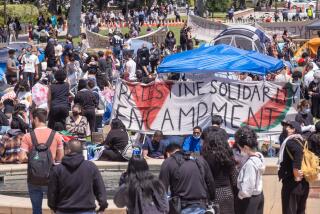A New Allegiance to the Veil : FEMALE WARRIORS OF ALLAH : Women and the Islamic Revolution <i> by Minou Reeves (E. P. Dutton: $17.95; 210 pp.; 0-525-24712-2) </i>
- Share via
In the decade since the overthrow of the regime of Shah Mohammed Reza Pahlavi and the start of the Iranian revolution, a virulent strain of Islamic fundamentalism has spread throughout the Muslim world, espousing a social order that appears to promote medieval attitudes, to restrict individual freedoms and to foster misogynist beliefs. Yet, women in one Muslim country after another, many of them educated in the West, have flocked to its banner, repudiating Western clothing and value systems and declaring themselves willing to fight and die for their beliefs.
Those early Western-inspired feminist movements in such countries as Egypt, Iran, Lebanon and even Turkey, which sought to improve the lot of women through legislation limiting polygamy and restricting men’s freewheeling divorce and custody rights, appear to be dead. In their place have emerged widespread demands to return to Islamic roots, to rescind foreign-inspired legislation, to reintroduce Islamic sharia law, to re-segregate educational systems. And everywhere, women appear in the forefront of a movement to return to a seemingly outmoded way of life, one that restricts their activities and limits their choices.
Minou Reeves seeks to explore the reasons for the resurgence of Islam in the late 20th Century, to explain the baffling paradox of women who freely sacrifice their lives in war, bravely engage in guerrilla attacks, actively take part in combat, yet voluntarily return to the veil, historically a symbol of their exclusion from public life.
In seeking to uncover the sources of a phenomenon that has baffled and even frightened many world leaders, the author links the resurgence of Islamic traditions to anti-Western attitudes, whose roots lie in centuries of confrontation between the West and the Islamic world, and more recently in “anti-colonialist” and “anti-imperialist” sentiments born of post-World War II experiences with foreign powers.
She outlines the historical development of repressive customs and attitudes toward women in Muslim societies, in spite of Islam’s originally liberating and progressive tenets. She delineates the absorption into Islam of such pre-existing local customs and practices as veiling and polygamy, showing how obscurantist exegetes reinforced the misogynistic attitudes of patriarchal societies.
She follows the emergence in the late 19th and early 20th centuries of Muslim reformers in Egypt and Tunisia who objected to misogynistic interpretations of the Koran and the hadith (the sayings of the prophet Muhammad). She touches upon early 20th-Century reforms in such countries as Tunisia, Iran and Turkey, which resulted from attempts at modernization inspired by Western models. She sees feminism within the broader framework of nationalist and socialist tendencies of the time.
The major contribution of this book lies in the author’s sketching of the larger historical and political framework for today’s Islamic revival and in making it clear that the resurgence of Islam cannot be understood outside of the nationalist revival. The author has tackled a large and complex subject and has managed to weave together many strands into a comprehensible and valuable whole.
A narrower focus, however--on Iran alone--might have made this an even more valuable book. The author has spread herself thin by attempting to cover too much. Although she singles out Iran as the major moving force behind the Islamic revival, in touching on events in a number of other Muslim countries she neither does justice to them, nor to Iran. Had she concentrated exclusively on the Iranian revolution, the author might have succeeded in exploring the resurgence of Islam in far greater depth.
She might, for example, have examined in more detail--and with actual anecdotal accounts--the difficulties that a tradition-bound and underdeveloped country such as Iran faced when trying to compress several hundred years of modernization into one or two decades. She might have explained what cultural aspects of Western culture have been so offensive to Muslim sensibilities as to have provoked violent rejection.
She might have recounted, through the testimony of those who lived through the revolution, what it was like to have experienced the trauma and the chaos of those times. She might have studied, through the words of Iranian religious leaders (many of whom are at odds with one another), the unresolved conflicts over national goals, philosophy, and identity that continue to plague Iran and that, at a deeper level, were to some degree responsible for the force of the explosion that rocked this ancient land.
Furthermore, by limiting her sources to published documents, the author, in the end, does not succeed in leading the reader across the cultural barriers to see events as an insider.
Despite these shortcomings, however, this book is a much-needed corrective to the paucity of objective information available to Western readers on the subject of Muslim women. It goes a long way toward combatting much disinformation, as well as misinformation, on the Muslim world in general and its women in particular.
Finally, writing as she was at the height of Iran’s xenophobic anti-Westernism, the author could not have foreseen the current trend in Iran toward moderation and pragmatism, as exemplified by the ending of the Iran-Iraq war. Recalled from the front, women are having to put down their arms and set aside their virulent anti-Western rhetoric. What role they will be allowed to play, amid the high unemployment and economic chaos of their war-torn and revolution-ravaged land, remains to be seen. But that is another chapter, and it has not yet been written.


